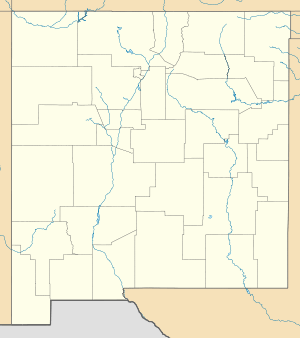Villa Philmonte
|
Villa Philmonte Historic District | |
|
The façade of the Villa Philmonte | |
  | |
| Location | Colfax County, New Mexico, USA |
|---|---|
| Nearest city | Cimarron, New Mexico |
| Coordinates | 36°27′33.06″N 104°56′55.99″W / 36.4591833°N 104.9488861°WCoordinates: 36°27′33.06″N 104°56′55.99″W / 36.4591833°N 104.9488861°W |
| Built | 1926 |
| Architect | Edward Buehler Delk |
| Architectural style | Mission/Spanish Revival |
| NRHP Reference # | 95001018[1] |
| Added to NRHP | August 18, 1995 |
Villa Philmonte is a large ranch home located outside of Cimarron, New Mexico, on Philmont Scout Ranch, owned by the Boy Scouts of America.
Background
The Villa was built in 1926 by oil magnate Waite Phillips who used it to oversee his 300,000 acres (120,000 ha) cattle ranch in northeast New Mexico. It was built in a Mission and Spanish Colonial motif befitting the American Southwest. Phillips named the house by combining the first half of his name with monte, the Spanish word for mountain. In addition to the Villa, Phillips built several other retreats on his ranch’s property, including Fish Camp on the Agua Fria Creek and Hunting Lodge near Cimarroncito (now Philmont Scout Ranch camps).
Phillips donated the Villa, along with 91,538 acres (37,044 ha) of land and the Philtower office building in Tulsa, Oklahoma, to the Boy Scouts in 1941, supplementing a 1938 gift of 35,857 acres (14,511 ha) that had created the Philmont Rocky Mountain Scout camp, near Cimarron, New Mexico. The Boy Scouts of America has operated the property since that time and has opened the Villa to Scouts and visitors as a museum. Regularly scheduled tours are offered during the summer.
Furnishings
The Villa is lavishly furnished, and retains many of Phillips’ original furnishings and collections, including particularly notable displays of antiques and weapons. The building features a large courtyard with a fountain in the center, large columns, and numerous porticoes. The interior was decorated using an eclectic mix of European, American, and Southwestern furnishings. The grand piano in the entrance worth an estimated $200,000.
A small window on the second floor that looks towards the ranch was added to the house by Phillips after construction was completed. He wanted the window added so he could view a large rock formation on a nearby mountain. The rock was subsequently named Window Rock.
A display window on the stairs between the first and second floor shows a landscape of saguaro cacti and a wagon being pulled by horses. In fact, wagons on the Santa Fe Trail were pulled by oxen, and there are no saguaro cacti in the area of the ranch.
References
- ↑ National Park Service (2006-03-15). "National Register Information System". National Register of Historic Places. National Park Service.
External links
- Official Philmont Site about Villa Philmonte
- Home & Garden TV on the Villa
- Unofficial Philmont Web Page
- Pictures of the Villa
- Voices of Oklahoma interview with Elliot "Chope" and Virginia Phillips. First person interview conducted on May 5, 2009 with Elliot "Chope" and Virginia Phillips, son and daughter-in-law of Waite Phillips. Original audio and transcript archived with Voices of Oklahoma oral history project.